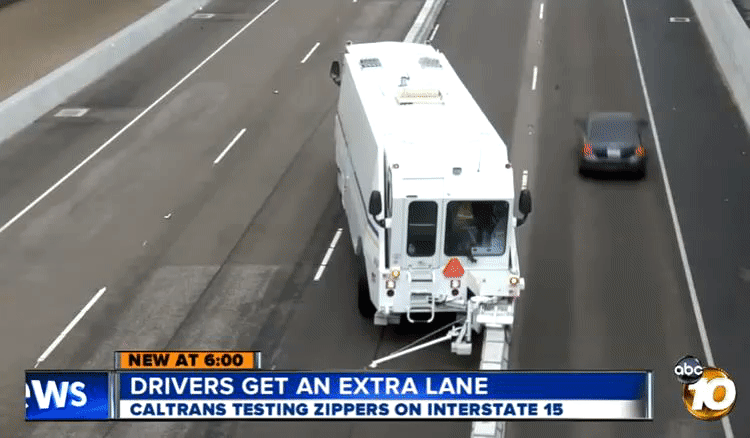From everyday lane switches to periodic construction detours, being able to modify lanes quickly, easily and safely with machines helps both drivers and road workers alike. Faster operations reduce time in transit and frustration for people in cars. And as that traffic is flying past, lane-modifying vehicles also help reduce risks for construction workers (who might otherwise by put in harm’s way).`
Median Moving Machines
Delays are especially problematic for long-span bridges like the Golden Gate in San Francisco. Bridges have fixed widths, meaning traffic engineers cannot add lanes and have to make the most of what is there. This heavily-trafficked bridge in particular is also hard to avoid or bypass when driving north (out of) or south (into) the city. Even during normal operations, it can get backed up in different directions as commuter traffic flows in by day and out at night.
Hence its Moveable Median Barrier system, a mechanical zipper that allows the number of lanes in each direction to be modified quickly. By day, four lanes help drivers access the city to the south (while two are left for those heading north). At night, the configuration is reversed. On the weekend, three lanes are left up in each direction.
In theory, drivers could be directed to stay in particular lanes without dividers, but in practice: there is a long history of head-on collisions on the bridge. This solution by Barrier Systems Inc contains over 3,000 extremely heavy linked units forming a robust central divider.
Each unit is made of concrete, wrapped and steel and weighs 1,500 pounds. Two dedicated trucks (or: “barrier transfer machines”) can each “zip” the lanes back and forth in a matter of minutes. The system is not limited to the Golden Gate Bridge or to San Francisco, but it is particularly useful in the ever-busy Bay Area.
Cone Collecting Machines
Heavy dividers can be robust and cost-effective solutions in some cases, but traffic cones also remain a convenient and lightweight way for road workers to mark out temporary lanes and direct vehicles during construction. A company called Traf-tek makes a machine that simplifies the collection of cones at the end of a project. Like some kind of reverse factory line, the cones are scooped up, set up in rows then pushed into the bottom of horizontal stacks.
But what about putting cones down in the first place? Researchers at the University of California, Davis’ AHMCT (Advanced Highway Maintenance & Construction Technology Research Center) started work on just such a “Cone Placement and Retrieval Vehicle” in the early 2000s. In partnership with Traf-tek, they developed this prototype machine that can carry hundreds of cones and place them neatly along roads faster and with less risk to workers. This machine was then tested by Caltrans (the California Department of Transportation).
Bonus: Bridge-Laying Machine
Of course, before lanes can be laid out on a bridge (let alone changed), that bridge has to be built. Construction methods vary, but this self-cantilevering crane placing stretches of prefab concrete is worth a look. The above video highlights a particularly dazzling part of the process while the one below shows more of this moving marvel on the road.




Comments (1)
Share
A similar cantilever machine was used in the recent construction of the Silver Line of the DC metro (in the Virginia suburbs). A shaky video here: https://www.youtube.com/watch?v=2CpSC4_7M8M